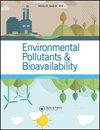Is the computed speciation of copper in a wide range of Chinese soils reliable?
Q3 Chemical Engineering
引用次数: 3
Abstract
Abstract Free Cu species in soils is a key issue to its bioavailability. However, predictive models for Cu speciation across a wide range of soils were still unavailable. In this study, Cu speciation in 34 contaminated soil samples were investigated via analytical technique and predictive models. The results showed that most of free Cu2+ was underestimated when using default log KCuFA and 65% active fulvic acid as inputs in models of WHAM VI and NICA-Donnan. The best prediction was found when using either adjusted active fulvic acid from 10% to 125% for WHAM VI or from 15% to 65% for NICA-Donnan model with the RMSE < 0.32 and r2 > 0.96. In contrast, NICA-Donnan demonstrated a slightly stronger binding for Cu than WHAM VI due to extra 26% of samples was underestimated. This work presents a comprehensive database of Cu speciation and an effective attempt of free Cu2+ prediction in a wide range of Chinese soils.计算出的中国土壤中铜的形态是否可靠?
摘要土壤中游离铜物种是影响其生物利用度的关键问题。然而,在广泛的土壤中,铜物种形成的预测模型仍然不可用。本研究采用分析技术和预测模型对34个污染土壤样品中的铜形态进行了研究。结果表明,在WHAM VI和NICA Donnan模型中,当使用默认对数KCuFA和65%活性黄腐酸作为输入时,大多数游离Cu2+被低估了。当WHAM VI使用10%至125%的调节活性黄腐酸或NICA-Donnan模型使用15%至65%的调节活性黄腐酸时,发现最佳预测,RMSE<0.32,r2>0.96。相比之下,NICA Donnan证明了比WHAM VI对Cu的结合略强,因为额外26%的样品被低估了。这项工作提供了一个全面的Cu形态数据库,并为中国土壤中游离Cu2+的预测提供了一次有效的尝试。
本文章由计算机程序翻译,如有差异,请以英文原文为准。
求助全文
约1分钟内获得全文
求助全文
来源期刊
CiteScore
1.62
自引率
0.00%
发文量
0
审稿时长
1 months
期刊介绍:
Chemical Speciation & Bioavailability ( CS&B) is a scholarly, peer-reviewed forum for insights on the chemical aspects of occurrence, distribution, transport, transformation, transfer, fate, and effects of substances in the environment and biota, and their impacts on the uptake of the substances by living organisms. Substances of interests include both beneficial and toxic ones, especially nutrients, heavy metals, persistent organic pollutants, and emerging contaminants, such as engineered nanomaterials, as well as pharmaceuticals and personal-care products as pollutants. It is the aim of this Journal to develop an international community of experienced colleagues to promote the research, discussion, review, and spread of information on chemical speciation and bioavailability, which is a topic of interest to researchers in many disciplines, including environmental, chemical, biological, food, medical, toxicology, and health sciences.
Key themes in the scope of the Journal include, but are not limited to, the following “6Ms”:
Methods for speciation analysis and the evaluation of bioavailability, especially the development, validation, and application of novel methods and techniques.
Media that sustain the processes of release, distribution, transformation, and transfer of chemical speciation; of particular interest are emerging contaminants, such as engineered nanomaterials, pharmaceuticals, and personal-care products.
Mobility of substance species in environment and biota, either spatially or temporally.
Matters that influence the chemical speciation and bioavailability, mainly environmentally relevant conditions.
Mechanisms that govern the transport, transformation, transfer, and fate of chemical speciation in the environment, and the biouptake of substances.
Models for the simulation of chemical speciation and bioavailability, and for the prediction of toxicity.
Chemical Speciation & Bioavailability is a fully open access journal. This means all submitted articles will, if accepted, be available for anyone to read, anywhere, at any time. immediately on publication. There are no charges for submission to this journal.

 求助内容:
求助内容: 应助结果提醒方式:
应助结果提醒方式:


